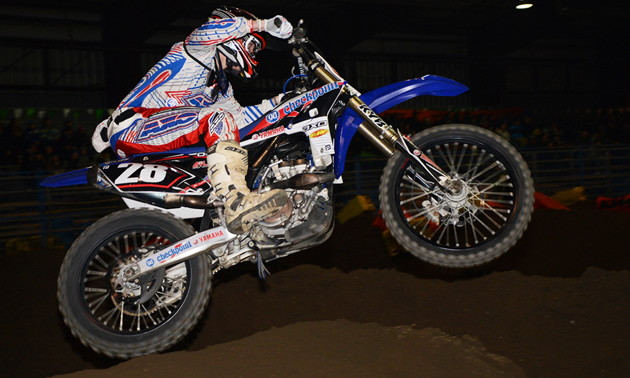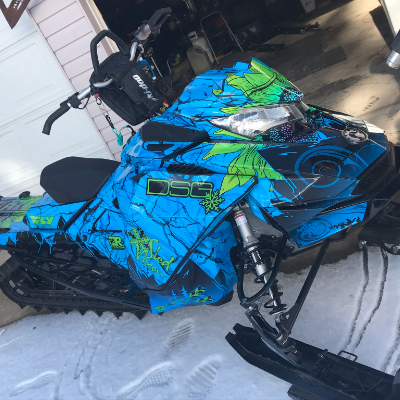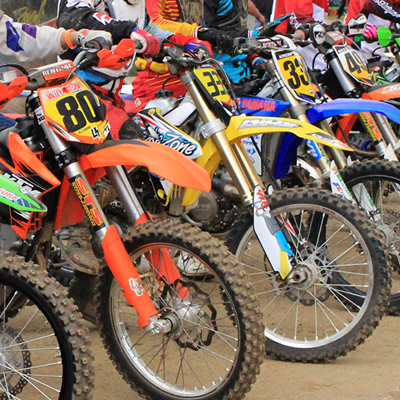All too often, in a series like this, we see one rider run away with the points lead so that later rounds have little meaning. Not so in this series. After Friday night’s racing, in fact, Spenny and Brock were tied in points in the Pro Open class. I had a knot in my stomach as each race began—the tension building with each passing round.
I was more than a little curious to see how Klatt would stack up in the tight confines of the arena, and wondered if he’d play the part of spoiler. I had my doubts. I wasn’t sure even a rider as talented as Klatt could give these guys six rounds of practice and walk in at their speed. As Knowles said after the fact, though, “He’s not a four-time National Champion for nothing.” Klatt won the first main of the weekend and was on the podium in all but one of the finals over the course of the weekend. Yeah, he was fast.
In the end, though, only one man put himself on the podium in every race. Knowles collected three second-place wins and a first-place win and inched ahead a little more in both classes. I asked him before racing started if he would be racing more conservatively to protect his points leads. His answer was a little slow and slightly hesitant, like he had to think it through, or as if his answer was difficult to put into words. He said, “Pretty much.” I wasn’t exactly sure how to read his answer but if I had to guess I think what he meant was, “I know I probably should, but screw that, I want to win.” As it turned out, Spenny did ride like he wanted to win—the championship.
The Amateurs—the question of safety
I wish these events were better attended in the amateur ranks and in the original draft of this article I expressed an opinion as to one reason ridership might be down. I suggested safety might be an issue keeping amateur riders away and that more attention to making the tracks safer would be beneficial for both the promoter and the sport in general. This resulted in what started out as a very angry phone call from Future West promoter John Hellam, but ended up being a good and hopefully productive conversation on the topic.
I was relieved to hear that safety is in fact a primary concern of Hellam’s and that great lengths are gone to in order to improve safety. He told me several times that his grandson, whom he loves more than anything in the world, races on these tracks and he argued that he wouldn’t let him race if he didn’t think the tracks were safe. He also told me that he has spent a considerable amount of money replacing hay bales with foam safety cubes and had put in a forgiving safety fence all the way around the track. Then he reminded me that the track is built early in the week, and that changes are made as the week progresses and problem sections are identified.
I still believe that arenacross by its very nature is more dangerous than outdoor motocross and that there were some things that could have been improved on this weekend’s track in particular, but perhaps I’m just splitting hairs.
Motocross, in all its various forms, is dangerous. Perhaps the higher than usual number of accidents that weekend did have more to do with the competition heating up than with track design, as Hellam suggested. Nonetheless, the conversation eventually got around to Hellam asking what he and the rest of the MX community could do to make it safer for amateurs and this is where the conversation got productive. It was also the exact moment Hellam earned my respect.
We talked about a few things that could be done differently with the tracks and then Hellam hit on what is probably the most important thing that can be done; it involves the riders and their parents as much as it involves the track builders.
I mentioned in my original article that I won’t let my kid race these races and I know many other families who feel the same way. The fact is, my son isn’t experienced enough with this kind of track and neither are many other kids used to racing outdoors. Hellam pointed out that the best thing we can all do is to take advantage of the fact that the track is there all week to practise on. Making an effort to ride the track during the week not only allows the kids to get used to the track before encountering it in a racing situation, but it also allows the track designers to identify any potentially dangerous elements and make the changes required before racing begins. Sure, this can be expensive and time consuming, but so is paying for an ambulance to go sit at the hospital for six hours!
I’m legitimately sorry that my words were misconstrued as a personal attack—my intention was to get to the bottom of why more people don’t race these races. In the end, though, I think it’s a discussion that has to happen if the series is to grow. These tracks are designed to be entertaining when the pros ride them, and finding a safe compromise for the amateurs is a tough business. I feel for Hellam in this regard.
That weekend, the series lost 85-cc 12-16 leader Devin Sache to a serious bone break, as well as junior contender Kyle Maskell. Other class contenders, such as Riley Paulik, Jacob Piccolo and Jesse Pettis (among many others) have all suffered major crashes during the series. Losing such a high number of riders to crashes isn’t good for racing. In many classes, the standings more accurately reflect who has or hasn’t crashed more than they reflect who is fastest.
After our discussion, I believe Hellam when he says he does anything and everything he can do to ensure the safety of riders and I think he’s right in saying parents need to do their part as well. If your little racer has limited experience on an arenacross track, or even if he's grown up racing them, get him out to practise before sending him out to race. If more people did this, it couldn’t help but reduce the element of danger on race night. It helps prepare the riders and also helps the promoter prepare the track.
Amateur racing
That being said, there are many classes where the points are close and the final four rounds are going to be very intense and exciting. I haven’t written about the ATV class to date, but the front three riders—Logan PrachNau, Andrew Vincent and Ethan Groothof (when he attends)—put on a great show every week. It’s quite the spectacle to see these vehicles hit the double jumps and power drift through the corners. It would be great to see ATV racing grow here in B.C.
While much has been made of riders like Jacob Piccolo and Casey Keast in the mini classes, Julien Benek has quietly slipped into the lead in the 50-cc 7-8, and the 65-cc class, as well as second in the 50-cc open class behind co-leaders Devon Smith and Nick Van Meel. Benek hasn’t beaten Piccolo straight up and he isn’t likely to, but he has shown that he has considerable speed and has avoided the big fat zeroes that Piccolo scores when he crashes. Benek is at least a year behind Piccolo and is a burgeoning star in his own right.
I’m fresh out of things to say about Piccolo, except that every time I see him I’m more impressed than the time before. This weekend he did two things that impressed the hell out of me. In the supermini class, he rode the wheels off his little 65-cc KTM and was pushing the pace of Casey Keast on his 100-cc Yamaha. Bearing in mind that Keast is commonly talked about as being the fastest mini rider on the West Coast and is among the best in the country, this is just about incomprehensible—and yet, it’s true. But Piccolo’s speed has never been in question.
The second thing I think I might have seen, though, was something new, and pertains to Piccolo’s one potential pitfall—his Kryptonite. This weekend, I might have seen a tiny bit of discretion on Piccolo’s part! I think I actually saw him back off the throttle once or twice as he approached lappers and once I’m pretty sure he resisted the urge to jump over another rider. There is no one who has seen him ride who would not admit he is among the fastest things they have ever seen on a mini, but the rub has always been that he doesn’t know when to back off and that he might never fulfill his promise as a result.
I saw an inkling of maturity in this respect this weekend, but in the end, when he got caught in traffic and he saw Keast pulling on him by a fraction of a second, those old instincts kicked in and he cartwheeled through the whoops, trying to pick his way through traffic at full speed. Once again, he bounced back up, but we all watch this young phenomenon with an aching dread that one of these times he might not. It’s some kind of oxymoron that Piccolo’s need for speed and desire to win are at once what make him so special and also what looms as the primary potential cause of his downfall.
When you add Tyler Gibbs into the mix, who currently leads the 85-cc 7-11 and supermini classes, it’s safe to say there is a lot of talent in the mini pool at the moment in B.C. (and I can’t forget Island riders like Harrison Bradley and Wyatt Youland). Some of the lustre falls off of Gibbs when he’s living in a world that contains Piccolo and Keast, but in reality he has all the skills to compete with these kids, and we all know how time has the ability to swap things around. Gibbs may play second fiddle at the moment, but by the time these kids hit the intermediate/pro ranks a lot can happen. Those of us who have been around awhile know that mini racing results are an indicator, but far from a rock solid predictor, of how things will shake out down the road.
A case in point is the current points battle going on in both the 250 and open junior classes. Wyatt Waddell and Riley Paulik are within four points of each other in both classes. Waddell is one of those names, along with Jesse Pettis and Tron Cathcart, whose racing speed was well known to me long before I ever saw him ride—he was a mini superstar. Riley Paulik, on the other hand, not so much. Yet here they are, eight rounds into the series, and virtually tied. When I see them race, my gut tells me that Waddell is faster, but the evidence makes this hard to support. True, this is one of those instances where Waddell’s crashes have played a big part in the closeness of the points battle, but I’ve always contended that consistency and crashing are elements of speed—so I’m reluctant to use this to say Waddell’s faster.
This weekend, they swapped moto wins in the open class and likely would have done the same in the 250 class, except that this time Paulik crashed, and hard, and scored no points with his DNF. To be fair, in the two races Paulik won, Waddell overcame some substantial hurdles just to finish second. In the first instance, he slid out, crashed, and then came from last to second on a track I’ve gone to great lengths to describe as difficult to pass on, and in the second, he clipped a fallen rider, bent his shift lever and rode out the rest of the race in first gear. Again, though, this all counts too!
Regardless, the last four rounds should provide some great racing as long as Paulik’s injured foot is OK to race on and doesn’t hamper his progress. The closeness of this battle should also serve as motivation for those younger riders riding in the shadows of mini superstars—with hard work and a little luck, anything can happen in motocross.
The Intermediates
Consistency is also proving to be the most valuable asset in the intermediate class. While Jesse Pettis gets all the hype, he has also eaten the most dirt and Ethan Ladd led the series coming into this weekend. With Ethan missing this round, however, (apparently he tweaked his knee snowboarding—I don’t know why these kids engage in such dangerous activities!), Kyle Springman has quietly taken over the lead in both intermediate classes.
Springman followed Pettis over the line in both races Friday night, then came from the back of the pack to finish third in open intermediate on Saturday and he toughed out a moto in the 250 class after he got pushed over the berm in the first corner and then tucked the front end going for a last corner stuff. The most exciting intermediate race of the weekend, though, was Saturday's open final that saw a race-long relentless attack by Jesse Pettis as he tried to overtake Skyler Archer, with Kyle Springman closing in on both throughout. In the end, Archer pulled out all the stops and kept Pettis behind him and Springman ended up right on their heels.
It was some great racing, and all of these riders showed they’ll be ready for the pro class before long. Springman did, in fact, ride the pro class this weekend, and spent some time running in fourth. He didn’t look out of place throwing it down with the big boys.
The Pros
Turnout for the pro class was just short of dismal. There were eight pros and two intermediates brave enough to line up with them. In reality, there were five guys capable of winning, though, and they did put on a good show. Also, on the bright side, at least there was a full gate, although there wasn’t enough riders to run qualifiers so the same 10 guys raced before the intermission just for gate pick.
I was really excited watching the first qualifiers when it was evident that Ryan Lockhart was on his game and looked to have the speed to run at the front of the pack. If there was a championship for “nice guy” in the pro class, Ryan would win it hands down. He’s always smiling, takes time for the kids and his years of experience provide him with an appreciation and perspective on the sport that only a seasoned veteran can have.
At the ripe old age of 28, Lockhart is the old man of Canadian Pro motocross and his unlikely comeback this year is the kind of story legends are made of. He started the season as a retired motocrosser wrenching for Kyle Keast, but when Keast broke his leg, Lockhart went on a six-week crash training course and took over Keast’s ride. To even his own surprise, he managed to run near the front of the pack at several national events and he snagged a couple top 10 finishes. Unfortunately, he went down in his qualifier Friday night and was hobbling around on a gimped ankle the rest of the weekend. He wasn’t quite up to the pace of the top four after that. He finished fifth in every race except Saturday’s Lites main when Brad Nauditt crashed and he snagged a fourth.
There was incredible parity between the top four guys this weekend. Spencer Knowles, Dusty Klatt, Brad Nauditt and Brock Hoyer were almost indistinguishable in speed. Almost without exception, these four finished in the order they started in (other riders aside) and all four won a main during the weekend. I’m a number cruncher, though, and by the very nature of being a semi-fanatical racing fan I feel an irrepressible urge to name a winner on the weekend. If you add up their finishes (so low score wins) the weekend results look like this: Spencer Knowles - 7, Dusty Klatt - 10, Brock Hoyer - 11, Brad Nauditt - 14. I don’t for a minute believe that this system is at all meaningful, but it helps me sleep. There are, however, a couple meaningful things I can say.
Brad Nauditt was the only rider to try riding a big-bore bike in the open class, which proved to be a worthwhile gamble. His 45 points on the weekend in the class was one better than Knowles’s 44 points. His perfect block pass on Knowles in Saturday's open class win was also the only pass I recall any of the top four making on any of the others (which is not to say it didn’t happen, but I was busy taking photos). Nauditt didn’t get many great starts this weekend and had ample opportunity to demonstrate just how good he is at the arenacross block pass. He rates fourth by my wonky point system, but in some ways, he was the most impressive.
Brock Hoyer hasn’t looked like he had quite the same speed as Knowles or Nauditt so far this season, and hadn’t won a main until this weekend. When he got out in front of Friday’s open main ahead of Knowles, I expected it was just a matter of time before Spenny put the moves on him—but it never happened. Hoyer rode flawlessly and never gave Spenny more than a sniff, and was able to slam the door when he had to. Hoyer appeared to be the most improved on the weekend.
Klatt just plain looked awesome—and smart. Perhaps his bicycle skills serve him well in arenacross, or perhaps it’s just his general racing savvy, but it was easy to see why this guy wins championships. He was the only guy scrubbing the hip jump on Friday night and thereby getting his wheel back on the ground making time every lap. Then he was the first one to swap up his line when one particular berm got soft and started sucking up momentum. He hit it once, lost speed and then tightened his apex to avoid it the very next lap. It took everyone else a few more laps to figure it out. I think Spenny should be grateful Klatt didn’t do the whole series.
The one to watch
Which brings me to Spenny. He did what he had to do and then some. He scored more points than anyone on the weekend, and he did it without riding in his red zone. He looked comfortable at all times and appeared to be riding well within himself. Yes, Nauditt passed him and yes, Hoyer stayed ahead of him, but I wouldn’t read too much into that. When Nauditt put his front wheel in on Spenny, I saw him check up and give him lots of room and, telepathically, I heard him say, “You can have the spot—just don’t take me out!” And when he was chasing Hoyer, I heard him thinking, “All right, I’ll chase you, but I’m not going to get dragged into anything nasty!” Then when he was on the podium after the last race I was thinking, “Good boy, you did what you had to do,” and I heard him thinking back at me, “Pretty much.” And now I know exactly what that means!








Comments